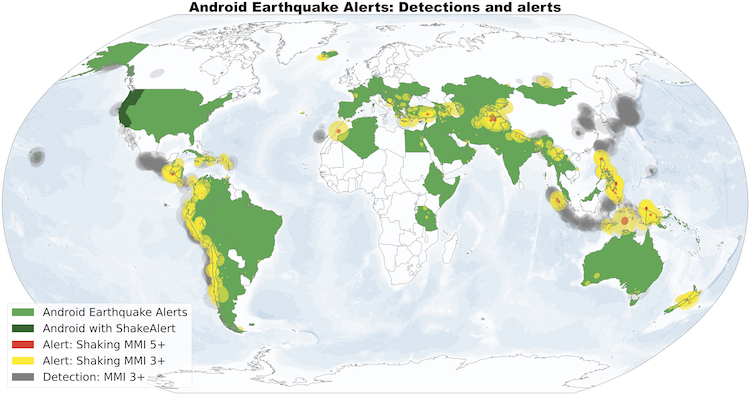Science
Android Smartphones Become Effective Early Warning System for Earthquakes

A groundbreaking study led by researchers at Google has revealed that the global network of Android smartphones can serve as an effective early warning system for earthquakes. This innovative approach provides users with critical seconds to prepare before seismic activity begins. The findings, published in the journal *Science*, are based on three years of research involving millions of devices across 98 countries.
The study, co-led by Richard Allen, a visiting faculty researcher at Google and the director of the Berkeley Seismological Laboratory at the University of California, Berkeley, underscores the potential of the Android Earthquake Alert (AEA) system. With Android smartphones constituting approximately 70% of the global smartphone market, the AEA system could facilitate life-saving warnings in regions lacking traditional seismic detection technology.
Smartphone Technology Meets Earthquake Detection
Traditional earthquake warning systems rely on costly networks of seismic sensors specifically designed to detect seismic activity. Initially implemented in countries such as Mexico and Japan, these systems have expanded to include regions like Taiwan, South Korea, the United States, Israel, Costa Rica, and Canada. When an earthquake occurs, these systems can quickly issue warnings, allowing individuals to take protective actions, such as the widely recommended “drop, cover, and hold on” (DCHO) method.
Building such networks, however, is not financially feasible for many earthquake-prone areas. In contrast, nearly everyone has access to smartphones equipped with built-in accelerometers. In the late 2010s, researchers began exploring how these accelerometers could be utilized to detect earthquakes. Although less sensitive than traditional sensors, smartphones can still register significant tremors during strong seismic events.
By the end of the study period from 2021 to 2024, Allen and his team, including co-leader Marc Stogaitis, a principal software engineer at Android, had tested the AEA system extensively. During this timeframe, the app detected an average of 312 earthquakes per month, with magnitudes ranging from 1.9 to 7.8, encompassing events in Japan and Türkiye.
Alerting Users to Earthquake Risks
For earthquakes measuring 4.5 or higher on the Richter scale, the AEA system dispatched “Take Action” alerts to users. These notifications are designed to grab attention immediately and encourage protective measures. On average, the system sent out 60 alerts per month, reaching approximately 18 million individual notifications monthly. Lesser “Be Aware” alerts were also issued for regions anticipated to experience shaking intensities of 3 or 4.
To evaluate the effectiveness of the alerts, the researchers collected voluntary feedback through user surveys conducted via Google Search. Between February 5, 2023, and April 30, 2024, they received responses from 1,555,006 individuals after receiving AEA-generated alerts. Findings indicated that 85% of respondents reported experiencing shaking, with 36% receiving their alert before the ground moved, 28% during the shaking, and 23% afterward.
The AEA system operates on principles similar to traditional seismic detection systems. When stationary, an Android smartphone utilizes its accelerometer to detect sudden acceleration changes caused by P and S waves during an earthquake. Upon detection, the phone transmits the acceleration data and its approximate location to Google servers, which analyze the information to identify potential seismic sources.
Once a candidate earthquake source is verified with sufficient confidence, the system estimates the earthquake’s magnitude, hypocenter, and origin time based on the arrival time and amplitude of the seismic waves. This capability is integrated into Google Play Services and is typically enabled by default on most Android devices, making it accessible to billions of users globally.
Looking ahead, Allen and his colleagues aim to enhance the AEA system’s capabilities and develop additional hazard-reducing tools, such as ground shaking maps to aid emergency responses post-earthquake. “We are learning from earthquakes occurring around the globe, and the Android Earthquake Alerts system is rapidly collecting information about these disasters,” Allen stated. “We believe we can continue to refine both the quality of our earthquake detections and our strategies for delivering effective alerts.”
With this innovative use of smartphone technology, the AEA system stands to significantly improve earthquake preparedness and response in regions worldwide.
-

 Entertainment2 months ago
Entertainment2 months agoIconic 90s TV Show House Hits Market for £1.1 Million
-

 Lifestyle4 months ago
Lifestyle4 months agoMilk Bank Urges Mothers to Donate for Premature Babies’ Health
-

 Sports3 months ago
Sports3 months agoAlessia Russo Signs Long-Term Deal with Arsenal Ahead of WSL Season
-

 Lifestyle4 months ago
Lifestyle4 months agoShoppers Flock to Discounted Neck Pillow on Amazon for Travel Comfort
-

 Politics4 months ago
Politics4 months agoMuseums Body Critiques EHRC Proposals on Gender Facilities
-

 Business4 months ago
Business4 months agoTrump Visits Europe: Business, Politics, or Leisure?
-

 Lifestyle4 months ago
Lifestyle4 months agoJapanese Teen Sorato Shimizu Breaks U18 100m Record in 10 Seconds
-

 Politics4 months ago
Politics4 months agoCouple Shares Inspiring Love Story Defying Height Stereotypes
-

 World4 months ago
World4 months agoAnglian Water Raises Concerns Over Proposed AI Data Centre
-

 Sports4 months ago
Sports4 months agoBournemouth Dominates Everton with 3-0 Victory in Premier League Summer Series
-

 World4 months ago
World4 months agoWreckage of Missing Russian Passenger Plane Discovered in Flames
-

 Lifestyle4 months ago
Lifestyle4 months agoShoppers Rave About Roman’s £42 Midi Dress, Calling It ‘Elegant’









